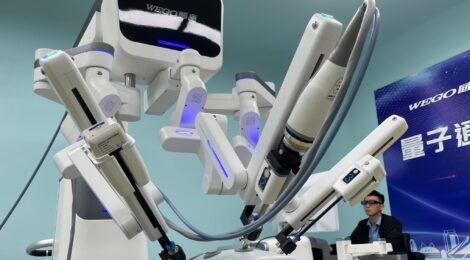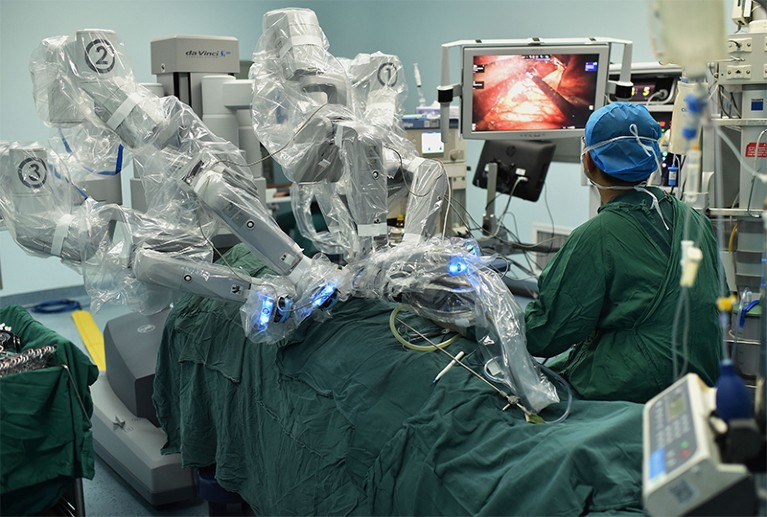
China Robotics Rise 4 – Medical Robots Part 1
1. INTRODUCTION TO THE SECTOR
In 2006, China highlighted the importance of robotics in its 15-year plan for science and technology. In 2011, the central government fleshed out these ambitions in its 12th five-year plan, specifying that robots should be used to support society in a wide range of roles, from helping emergency services during natural disasters and firefighting, to performing complex surgery and aiding in medical rehabilitation.
China’s robotics research output has been growing steadily for two decades, driven by three major factors: “The clinical utilization of robotics; increased funding levels driven by national planning needs; and advances in engineering in areas such as precision mechatronics, medical imaging, artificial intelligence and new materials for making robots.” Funding levels for medical robotics from the National Natural Science Foundation of China and the Ministry of Science and Technology began to increase more sharply in 2011 compared to the previous decade.
The accompanying rises in research output are closely related to the introduction of specialized robotics equipment in medical-research facilities. Between 1999 and 2019, the number of papers published by at least one Chinese author in the combined fields of biomedical engineering and robotics increased from 142 to 4,507, and spiked twice during that period, according to data from the Web of Science. One peak was in 2008, two years after a robotic system for minimally invasive operations called da Vinci was first deployed to hospitals in China. The second was in 2017, a year after the first Chinese-designed robot for minimally invasive spinal surgery was approved for sale.
In 2019, the number of da Vinci systems installed in Chinese hospitals that year leapt to 59, up from only 8 installations in 2018. This surge followed a 2018 government push to encourage research on robotics technology and its clinical application, according to Jian-Kun Hu, director of the department of gastrointestinal surgery at West China Hospital in Chengdu. The central government’s plan included an intention to purchase 154 new surgical robot systems by the end of 2020, and a breakdown of how the systems would be allocated nationwide.

A surgical robot equipped with cameras is carrying out its first cardiac surgery for a 31-year-old patient with congenital heart disease at the First Affiliated Hospital of Anhui Medical University in Hefei city, east China’s Anhui province
2. RECENT YEARS DEVELOPMENT
In recent years, with the rapid development of artificial intelligence, technological breakthroughs and the gradual broadening of application fields, the development of the medical industry has attracted much attention. With the deepening application of medical robots in the medical field in the era of artificial intelligence, medical robots can effectively help doctors perform a series of medical diagnosis and auxiliary treatments, and promote the development of medical informatization while effectively alleviating the problem of tight medical resources.
Medical robots belong to the category of special service robots among service robots. They refer to semi-autonomous or fully autonomous robots used in medical or auxiliary medical treatment in hospitals and clinics. They can complete service work that is beneficial to human health, but do not include engaging in production. Active equipment. Specifically, it can be divided into four categories: surgical robots, rehabilitation robots, auxiliary robots and medical service robots.

AI robot provides health check service to visitors at CIFTIS
Development status of the medical robot industry
- Advantages of medical robots
Medical robots are a new cross-research field that integrates medicine, biomechanics, mechanics, mechanical mechanics, materials science, computer graphics, computer vision, mathematical analysis, robotics and many other disciplines. It is a research field in the field of robots at home and abroad. Hotspot. Medical robots can reduce errors, be safer, can simulate surgeries, achieve comprehensive care, and reduce human resources. Moreover, machine programs can be set, and they are more patient, careful, and physiologically exhausted than traditional medical staff. A big advantage.
Medical robots have a wide range of application prospects. They are currently mainly used for the rescue, transport, surgery and rehabilitation of sick and wounded patients. The main products include surgical robots, rehabilitation robots, medical service robots, health service robots, etc. Among them, surgical robots mainly include laparoscopic, orthopedic, neurosurgery and other types, accounting for about 16%. With the continuous development of technology, surgical robots will develop toward miniaturization, specialization, low cost, intelligence, and automation, and will lead minimally invasive surgery into a new era.
- Market share of medical robots
At present, medical robots can be divided into four categories: surgical robots, rehabilitation robots, auxiliary robots, and medical service robots. In China’s medical robot market, rehabilitation robots account for the largest share, accounting for 47%, followed by auxiliary robots, accounting for 23%, surgical robots and medical service robots accounting for 17% and 13% respectively.
- Registration volume of medical robot companies
According to Qichacha data, there were only 2,761 medical robot-related companies in 2016, and the number of registrations exceeded 5,000 in 2019. Affected by the epidemic in 2020, the popularity of medical robots has skyrocketed, and the number of registrations of medical robot-related companies has increased by 158.3% year-on-year to 13,076, an increase of 3.74 times compared with 2016.
- Most of the upstream components in the medical robot industry are from foreign manufacturers.
The upstream of the medical robot industry chain is composed of raw materials, functional components and core components. The core components are mainly composed of servo motors, sensors, controllers and reducers; the midstream of the industrial chain is the manufacturing and system integration of medical robots; the industrial chain Downstream are equipment agents, medical institutions at all levels, etc. The main application scenarios are surgery, nursing, rehabilitation, patient transfer, and drug transportation. At present, our country is weak in these parts and components, and most of them rely on imports. The entire market is mainly occupied by the “four major foreign families” and other large manufacturers. Although our country is constantly developing core components and excellent companies have emerged, the overall competition is still weak.
- Market size of medical service robots
In recent years, China has clearly proposed the development of “high-performance diagnostic and treatment equipment such as medical robots”, and medical service robots have shown rapid growth. Data shows that China’s medical service robot market size reached 5.94 billion yuan in 2020. It was expected that China’s medical service robot market size would reach 7.96 billion yuan in 2021, and further reach 9.71 billion yuan in 2022.
At present, digitalization and intelligence have become important development directions for intelligent medical robots. With the gradual deepening of domestic industry-university-research cooperation and the pursuit of industrial hot spots by capital, the research and development of intelligent medical robot technology continues to accelerate, and products will be extended to more application scenarios.
- Medical robot companies will raise more than 3 billion yuan in financing in 2021
In 2021, more than 30 financing rounds occurred in the domestic surgical robot industry. Shurui Technology, Jingfeng Medical, Changmugu, etc. completed 2 rounds of financing within one year. Lancet Robot has completed 3 rounds of financing in a row in the second half of this year. The total financing amount of the track exceeds 3 billion yuan. The ability to quickly complete multiple rounds of financing in a short period of time fully reflects the core competitiveness and investment value of surgical robots. At the same time, with the support of financing, the growth rate of the market size of surgical robots will continue to accelerate.
See you next week with our second part of the article!
Written by Marco Bonaglia




